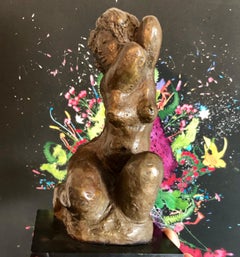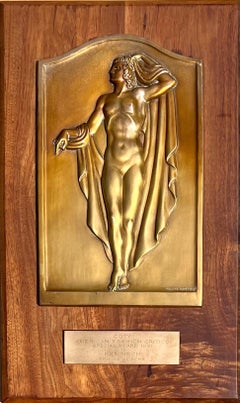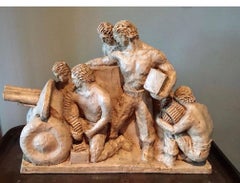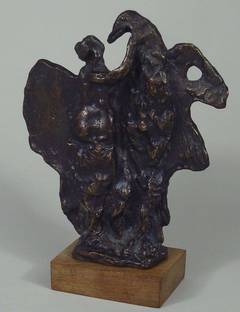Eugenie Gershoy Art
to
1
1
Overall Height
to
Overall Width
to
1
1
1
6,886
3,210
2,514
1,217
1
1
Artist: Eugenie Gershoy
Bronze Female Nude Sculpture Modernist, WPA, New York Chelsea Hotel Artist
By Eugenie Gershoy
Located in Surfside, FL
Eugenie Gershoy (January 1, 1901 – May 8, 1986) was an American sculptor and watercolorist. Eugenie Gershoy was born in Krivoy Rog, Russia (Krivoi Rog, Ukraine) and emigrated to New York City in the United States as a child in 1903. Considered somewhat of a child prodigy, Gershoy was copying Old Master drawings at the age of 5. Her interest and talent in art was encouraged from a very young age. Aided by scholarships, she studied at the Art Students League under Alexander Stirling Calder, Leo Lentelli, Kenneth Hayes Miller, and Boardman Robinson. Around this time, she created a group of portrait figurines of her fellow artists, including Arnold Blanch, Lucile Blanch, Raphael Soyer, William Zorach, Concetta Scaravaglione, and Emil Ganso, which were exhibited as a group at the Whitney Museum of American Art. At age 17, she was awarded the Saint-Gaudens Medal for fine draughtsmanship. Early in her career she became an active member of the Woodstock art colony. In Woodstock she experimented by sculpting in the profusion of indigenous materials that she found. Working with fieldstone, oak and chestnut, Gershoy created works based on classic formulae. As she became more interested in the dynamism of everyday life, she found that these materials and her idiom were too restrictive. By the time Gershoy came to Woodstock in 1921 her own individual artistic style was already evident in her sculptures. Eugenie Gershoy worked in stone, bronze, terracotta, plaster and papier-mache. Gershoy’s sculptures were mainly figurative in nature and many of her artist peers such as Carl Walters, Raphael and Moses Soyer, William Zorach and Lucille Blanch, became her subjects. Eugenie Gershoy’s works on paper should not be overlooked. She was the winner of the Gaudens Medal for Fine Draughtsmanship at the tender age of 17. Gershoy married Jewish Romanian-born artist Harry Gottlieb. In the late 1920s and early 1930s, the pair kept a studio in Woodstock, New York. There, Gershoy was influenced by sculptor John Flanagan, who lived and worked nearby.
From 1936 to 1939, Gershoy worked for the WPA Federal Art Project. She collaborated with Max Spivak on murals for the children's recreation room of the Queens Borough Public Library in Astoria, New York. She developed a mixture of wheat paste, plaster, and egg tempera, which she used in polychrome papier-mâché sculptures; she was the only New York sculptor to work in polychrome at this time. She also designed cement and mosaic sculptures of animals and figures to be placed in New York City playgrounds. Alongside others employed by the FAP, she participated in a sit-down strike in Washington, DC, to advocate for better pay and improved working conditions for the projects' artists.
Gershoy's first solo exhibition was held at the Robinson Gallery in New York in 1940. She moved to San Francisco in 1942, and began teaching ceramics at the California School of Fine Arts in 1946. In 1950, she studied at the artists' colony at Yaddo.
Gershoy traveled extensively throughout her life. She visited England and France in the early 1930s, and worked in Paris in 1951. She traveled to Mexico and Guatemala in the late 1940s, and also toured Africa, India, and the Orient in 1955.
In 1977, Gershoy dedicated a sculpture to Audrey McMahon, who was actively involved in the creation of the Federal Art Project and served as its regional director in New York, in recognition of the work McMahon provided struggling artists in the 1930s.
Gershoy's work is in the collections of the Whitney Museum of American Art, the Metropolitan Museum of Art, and the Smithsonian American Art Museum. Her papers are held at Syracuse University Grant Arnold introduced her to lithography in 1930 and Gershoy depicted many scenes of Woodstock artists and their daily activities through this medium. From 1942 to 1966 Gershoy lived and painted in San Francisco where she taught at the San Francisco Art Institute. She traveled extensively, filling sketchbooks with scenes of Mexico, France, Spain, Africa and India. During her later years Eugenie Gershoy returned to New York City and concentrated on numerous well received exhibitions. Her last exhibition in at Sid Deutsch Gallery included many of the sculptures that were later exhibited in the Fletcher Gallery.
John Russell, former chief critic of fine arts for the New York Times, writes about the 1986 Sid Deutsch exhibition:
“As Eugenie Gershoy won the Saint-Gaudens Medal for fine draftsmanship as long ago as 1914 and since 1967 has had 15 papier-mache portrait figures suspended from the ceiling of the lobby of the Hotel Chelsea, she must be ranked as a veteran of the New York scene. Her present exhibition includes not only the high-spirited papier-mache sculptures for which she is best known but a group of small portraits of artists, mostly dating from the 30’s, that is strongly evocative.”
Eugenie Gershoy is an artist to take note of for several reasons. She was a woman who received great awards and recognition during a time when most female artists were struggling to hold their own against their male counterparts. As a young girl she won a scholarship to the Arts Student League where she met Hannah Small...
Category
Mid-20th Century American Modern Eugenie Gershoy Art
Materials
Bronze
Related Items
1961 Coty Award Plaque Kenneth Hairdresser Jacqueline Onassis Bronze Fashion
Located in New York, NY
1961 Coty Award Plaque Kenneth Hairdresser Jacqueline Onassis Bronze Fashion
Bronze on wood. The wood plaque measures 12 3/4" by 20 3/4 inches. The bronze plaque itself is 13 3/4 x 8 3/4 inches and the the bronze inscription, which reads "COTY, American Fashion Critics Special Award 1961 to KENNETH of LILY DACHE...
Category
1960s American Modern Eugenie Gershoy Art
Materials
Bronze
2 Sculptures: "The Power" & "The Glory" WPA Depression WWII era mid 20th century
By Agnes Yarnall
Located in New York, NY
2 Sculptures: "The Power" & "The Glory" WPA Depression WWII era mid 20th century by Agnes Yarnall circa 1940s.
Sculptor, painter, poet and artistic historian, Agnes Yarnall has, since the age of six been breathing life into her art.
Renowned as a sculptor, whose commissioned portrayals of contemporary celebrities are prized. She has sculpted Judith Anderson, Edna St. Vincent Millay, Carl Sandburg...
Category
1940s American Modern Eugenie Gershoy Art
Materials
Plaster
"Pioneer Family" WPA American Modernism Plaster Maquette Realism 20th Century
By William Zorach
Located in New York, NY
"Pioneer Family," 23 1/2 x 16 1/4 x 10 3/4 inPlaster. c. 1927. Unsigned. Realism
The Smithsonian has a cast of this sculpture in its collection. Pictured on the cover of “The Sculpt...
Category
1920s American Modern Eugenie Gershoy Art
Materials
Plaster
Harmony, 20th century bronze & green marble base, nude man and woman with lyre
By Max Kalish
Located in Beachwood, OH
Max Kalish (American, 1891-1945)
Harmony, c. 1930
Bronze with green marble base
Incised signature on right upper side of base
14 x 9 x 5 inches, excluding base
17 x 10 x 8 inches, including base
Born in Poland March 1, 1891, figurative sculptor Max Kalish came to the United States in 1894, his family settling in Ohio. A talented youth, Kalish enrolled at the Cleveland Institute of Art as a fifteen-year-old, receiving a first-place award for modeling the figure during studies with Herman Matzen. Kalish went to New York City following graduation, studying with Isidore Konti...
Category
1930s American Modern Eugenie Gershoy Art
Materials
Marble, Bronze
Bust of a Man - Sculpture after Aurelio Mistruzzi - 1990s
Located in Roma, IT
Bust of a man is an original sculpture in bronze realized after Aurelio Mistruzzi in the late 1990s.
Bronze casting.
18 cm height, 24 cm height with wooden base.
Good conditions.
Category
1990s Modern Eugenie Gershoy Art
Materials
Bronze
Abstract Modernist Armless Female Nude Torso Bust Bronze Sculpture
Located in Houston, TX
Modernist nude bronze sculpture by Houston, TX artist David Adickes. The sculpture depicts an abstract armless female nude torse that stands on a wooden base. The piece is signed by the artist at the back of the sculpture's left leg.
Artist Biography: Born (1927) and raised in Huntsville, TX, David Adickes is an artist whose art and heart are closely aligned with Paris, France. After studying art at the Atelier F. Leger in the late 40s, Adickes burst onto the art scene in Houston and elsewhere in the early 50s and has been a prominent member of Houston’s art community ever since. While his most visible works are his giant sculptures, from the Virtuoso in downtown Houston...
Category
Early 2000s Modern Eugenie Gershoy Art
Materials
Bronze
Industrial Machine Age American Scene WPA Mid 20th Century 1939 SF World's Fair
Located in New York, NY
Industrial Machine Age American Scene WPA Mid 20th Century 1939 SF World's Fair
HAIG PATIGIAN (American/Armenian, 1876-1950)
Aeronautics Pediments
Two Plaster Casts, c. 1930s
each 13.25 x 14.75 x 6 inches
It's possible these moquettes were created for the 1939 World's Fair, the Golden Gate International Exhibition in San Francisco.
Provenance: Private Collection of Lois M. Wright, Author of "A Catalogue of the Life Works of Haig Patigian, San Francisco Sculptor, 1876-1950),” 1967
Loan to Oakland Museum of California (Oakland, CA)
BIO
Haig Patigian is noted for his classical works, which are especially numerous in public venues in San Francisco, California. Patigian was born in Van, Armenia, which at that time was under Turkish rule. Haig was the son of Avedis and Marine Patigian, both teachers in the American Mission School there. He and his older brother showed an aptitude for art early on and were encouraged by their parents. Their father himself had taken up the new hobby of photography. The 1880s were harsh times, however, for many Armenians under an oppressive rule by the Turkish government. Many people were fleeing to the safety of the United States. Suspicious Turkish authorities accused his father of photographing city structures for the Russian government, and in 1888 he fled for his life to America.
Haigs father made his way to Fresno, California, and began life anew as a ranch hand. Within two years he sent for his wife, as well as Haig, his three sisters and brother, and in 1891 the Patigians made the journey from Armenia. Haigs father, an industrious man, worked on various farms, and eventually bought his own ranch and vineyard. It was among fertile farmland of Fresno that Haig grew up.
Young Haigs education consisted of teachings by his parents and by intermittent attendance in public schools. Although he had dreams of becoming an artist, he did not have the opportunity for formal study of art, and began working long days in the vineyards around Fresno.
At age seventeen, Haig made a step towards his dreams and apprenticed himself to learn the trade of sign painting. In his spare time he nurtured his interest in art by painting nature and life scenes with watercolors and oil paints. When his sign-painting mentor left Fresno, Haig opened his own shop and made a name for himself in the town. San Francisco, in the meantime, had been attracting artists since the Gold Rush and had become a thriving art center. Within a few years, Haig had put aside several hundred dollars to move to San Francisco, joining his brother who was already working there as an illustrator.
In 1899, when he was twenty-three, Haig had saved enough money to enroll at the Mark Hopkins Art Institute in San Francisco. Like many aspiring artists of his time, Patigian supported himself by working as a staff artist in the art department of a local newspaper, and in the winter of 1900, nearing his 24th birthday, Haig began work for the San Francisco Bulletin, producing cartoons, black and white illustrations, as well as watercolors.
In 1902 tragedy struck Haig and his family. His 29-year-old brother died of pneumonia, and then his frail mother died a short time later. Five months more saw his youngest sister, just out of high school, die too. Saddened and depressed, Haig moved out of the studio he had shared with his brother, and into a dilapidated studio in a poor section of town. During this time of sadness, Haig fed a growing interest in sculpture.
In 1904 Haig created what he later called his "first finished piece in sculpture". The work, called "The Unquiet Soul", depicted a man thrown back against a rock while waves lash at his feet. The body was tense and twisted, with one hand, in Haig's own words, "searchingly leaning and clutching the rock, while the other masks his troubled head".
The Press Club of San Francisco, which Haig had joined in 1901, put "The Unquiet Soul" on exhibition and local headlines proclaimed "Local Newspaper Artist Embraces Sculptor's Art", and "First Work Predicts Brilliant Future". With the support of friends and community acclaim, the young illustrator left his newspaper job and became a professional sculptor.
The path of his new career was not easy though. Haig had never made much money working for the newspaper and his father needed help with growing debt from funeral expenses and business problems. From time to time Haig sold some artwork, but also occasionally borrowed from friends to pay the rent. He was the classic 'starving artist'.
In the spring of 1905 a white-bearded 81-year-old stranger knocked on Haig's door. It was George Zehndner, from Arcata, California. Zehndner had been born in Bavaria, Germany in 1824, the son of a farmer. In 1849 he had come to America looking for prosperity, settling in Indiana, where he worked on a farm and learned English. He found his way to the West Coast in 1852. Penniless, he worked in various jobs from San Francisco to Sacramento, then found some luck working in the gold fields of Weaverville in Trinity County, and eventually moving to a farm on 188 acres near Arcata. In his 77th year in May of 1901, Zahndner had taken a trip to San Jose, where he stood in a crowd to see a man he thought much of, President William McKinley. McKinley was popular as 'the first modern president' partially because he realized going out to meet the common person increased his support. In September of that year, however, an anarchist assassinated the president while he stood in a receiving line at the Pan-American Exhibition in Buffalo, New York. Soon after, the city of San Jose erected a statue of the slain president in St. James Park. Zehndner took a second trip to San Jose where he visited the McKinley monument. Touched, Zehndner decided that, no matter the cost, his town of Arcata too would memorialize McKinley.
George Zehndner had read about Haig in a newspaper article and asked if Patigian would create a heroic statue of the late President McKinley for Arcata. When asked how much it would cost, Haig responded, despite his borderline poverty, with the fabulous sum of $15,000. Zehndner agreed. The President was to be portrayed standing, wearing an overcoat, with his feet planted squarely on the ground. In the finished statue, one hand is held out before him in a typical posture of speaking, with the other hand holding the speech as his side. The 9-foot statue...
Category
1930s American Modern Eugenie Gershoy Art
Materials
Plaster
sabine
By Patrick Brun
Located in Pasadena, CA
Patrick BRUN was born in Paris in 1941. After obtaining his Engineering degree, he began his professional life as a teacher in mathematics and physics. After this period, he started ...
Category
21st Century and Contemporary Modern Eugenie Gershoy Art
Materials
Bronze
Iris little study, Auguste Rodin, Bronze, Sculpture, Modern Art, 1970's, Nudes
By Auguste Rodin
Located in Geneva, CH
Iris little study, Auguste Rodin, Bronze, Sculpture, Modern Art, 1970's, Nudes
Petite etude pour Iris, douzième épreuve
Ed. 12/12 pcs
1973
Bronze with brown and black patina
Marked...
Category
1970s Modern Eugenie Gershoy Art
Materials
Bronze
Ballerina on a baroque chair
Located in Sempach, LU
Sculpture from the Ballet series. The series is dedicated to classical ballet and includes over 30 sculptures. This sculpture depicts a dancer tying p...
Category
Early 2000s Modern Eugenie Gershoy Art
Materials
Metal, Bronze
Nude Walking, Early 20th Century Bronze Sculpture, Cleveland School Artist
By Max Kalish
Located in Beachwood, OH
Max Kalish (American, 1891-1945)
Nude Walking, 1930
Bronze
Signed and dated on base
17 x 9 x 4 inches
Born in Poland March 1, 1891, figurative sculptor Max Kalish came to the United...
Category
1930s American Modern Eugenie Gershoy Art
Materials
Bronze
Woman Seated A Bronze Sculpture of a Woman by Charles Rumsey
By Charles Cary Rumsey
Located in Brookville, NY
The bronze sculpture of a woman by Charles Rumsey is undated, but was created at a point in his career where he began to transition from realism to more modern, looser depictions of ...
Category
1920s American Modern Eugenie Gershoy Art
Materials
Bronze
H 10.5 in W 11 in D 6 in
Previously Available Items
Bronze Female Nude Sculpture Modernist, WPA, New York Chelsea Hotel Artist
By Eugenie Gershoy
Located in Surfside, FL
Eugenie Gershoy (January 1, 1901 – May 8, 1986) was an American sculptor and watercolorist. Eugenie Gershoy was born in Krivoy Rog, Russia (Krivoi Rog, Ukraine) and emigrated to New York City in the United States as a child in 1903. Considered somewhat of a child prodigy, Gershoy was copying Old Master drawings at the age of 5. Her interest and talent in art was encouraged from a very young age. Aided by scholarships, she studied at the Art Students League under Alexander Stirling Calder, Leo Lentelli, Kenneth Hayes Miller, and Boardman Robinson. Around this time, she created a group of portrait figurines of her fellow artists, including Arnold Blanch, Lucile Blanch, Raphael Soyer, William Zorach, Concetta...
Category
Mid-20th Century American Modern Eugenie Gershoy Art
Materials
Bronze
Leda and the Swan
By Eugenie Gershoy
Located in Los Angeles, CA
Fine bronze, signed and numbered. 8 Inches tall over all.
Beautiful patina, in fine condition.
The following is submitted by Cornelia Seckel, publisher Art Times
Profile: Eugenie Gershoy
By RAYMOND J. STEINER
Art Times November 1984
EUGENIE GERSHOY: an emigre from a pogrom-threatening Russia, a member of a distinguished family of the intelligentsia, a life-long artist whose career began before the age of four, a woman of eclectic tastes and cultured learning seasoned with a loving and satirical eyehow and where does one begin to capture her in all her facets? Largely a natural talent with a smattering of formal training, it has been through sheer force of her irrepressible creativity that she has attained a stature and versatility in the world of art that few can match.
Represented in almost every major collection (the Whitney Museum of American Art, the Metropolitan Museum of Art, the National Museum of American Art, the Syracuse Museum of American Art, the Delgado Museum of Art, Skidmore College of Fine Art, to name a few), she has exhibited her work in numerous shows from New York and west to San Francisco and south to New Orleans, culminating in her most recent, a special show of her sculptures entitled "Fantasy and Imagination in Sculpture" at the Smithsonian Institute in Washington, D.C. which will continue until January 20,1985.
Honors and awards began as early as 1914 when she received the St. Gaudens medal for fine draftsmanship and have continued throughout her career of creating, of teaching and active membership in over twenty gallery and art associations. A recent article in the Smithsonian was the last of almost fifty such pieces on either herself or on her art in various publications from across the country and from as early as the'30's. The astonishing diversity of her life's work is scarcely hinted at in the accompanying photographs.
To select any one aspect of Ms. Gershoy's life or work would, of course, lead to distortion and an incomplete picture of her contribution. Fortunately, in addition to being a fine artist, she is highly literate and capable of verbalizing her own growth and artistic concepts, sharing copious notes that she has saved over the years. (An example of her writing and expressions on art can be found in the "SPEAK OUT" section of this issue of ART TIMES.) A chronological highlighting of her career, therefore, seems the only way to do her justice.
Exposed to the "masters" in a collection of art books owned by her parents, Ms. Gershoy "drew assiduously from the age of three on" At five, she was copying Michelangelo, Rafael, and daVinci never suspecting that these were, in fact, reproductions of sculpture in three dimensions. Eventually, she drew from life, adding a lively sense of color as she experimented with crayons, colored inks, watercolors, and oils. At thirteen, she set about illustrating "Little Women."
Resolving to become a painter and illustrator, she took advantage of a scholarship and entered the Art Students League of New York. Disappointed that the painting class was full, she turned to leave only to be stopped by a young woman who suggested she take a modeling course instead. "What is modeling?" was her immediate response, not having any knowledge of sculpture up until that point. The young woman was Hannah Small...
Category
1950s Expressionist Eugenie Gershoy Art
Materials
Bronze
Eugenie Gershoy art for sale on 1stDibs.
Find a wide variety of authentic Eugenie Gershoy art available for sale on 1stDibs. You can also browse by medium to find art by Eugenie Gershoy in bronze, metal and more. Much of the original work by this artist or collective was created during the 20th century and is mostly associated with the modern style. Not every interior allows for large Eugenie Gershoy art, so small editions measuring 4 inches across are available. Customers who are interested in this artist might also find the work of Tom Binger, Dudley Vaill Talcott, and John W. Mills. Eugenie Gershoy art prices can differ depending upon medium, time period and other attributes. On 1stDibs, the price for these items starts at $2,800 and tops out at $2,800, while the average work can sell for $2,800.




